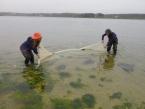Let’s Go An-Eeling
From winter editions of past Gazettes:
This is the season when runs the “long fish” of Indian lore, a season which was hailed as being of prime importance among Island residents of another day. The catching, selling and curing of eels was one of the regular occupations of the early Vineyarders. The eels enter the great ponds of the Island along with the perch and herring which come to spawn and seek the fresh water streams flowing into the ponds. The spring eel does not attract attention, but the fall run, when the eels seek salt water again, is a phenomenon that provides excitement and hard work.
It was the studied plan to have the pond beaches closed at this season of the year, when chilly nights might be expected and the “potting” of the eels began. The yellow-bellied eel is caught in baited pots with great success by those who know the art. Although the eel is a scavenger and when pursuing his own affairs will dine on almost anything, it will not enter a baited pot with anything but the freshest of fish, tiny menhaden, sand eels being preferred, and these must be seined daily to satisfy its discriminating taste.
There are a few men left on the Vineyard who may have built old-fashioned eel pots and know how they are made, but no one of today sits down on winter evenings, whittling out the long oak slats or splitting the wet pine roots. No metal was used, the slats laid and bent lengthwise and the pine roots used as lacings to form a bottle-shaped basket, with one end holding a funnel, the other being closed by a large wooden plug.
In early days the pond proprietors, or those who had shore rights and were entitled to set pots, would list the names of all suitable places in which to set pots, writing them on slips of paper. These were shaken up in a hat and drawn, each man receiving a location as his name was called until all the “sets” had been disposed of. It was felt this division was made as fair as possible.
Eelers are not plentiful these days, although a few men still sets pots in the great ponds, practicing the ancient art, and a few tons of eels are shipped annually to the Christmas market.
A supper of eels the other night was very, very good. Eels are not only delicious eating; it is a picturesque sight when eel fishermen work by torchlight along some sedgy inlet, with the ruddy light flickering over the agile motions of the spear-wielder and picking out the twisted branches of cedar or pine on the shore. Eels also are mysterious. No one had ever seen an eel’s egg, in all the four thousand years of history during which epicures had praised their white meat, until Marie Fish of Woods Hole and her husband, Dr. Charles Fish, accompanied William Beebe’s Arcturus expedition to the Sargasso Sea. Mrs. Fish retrieved from the haul of a drag net some tiny specks of jelly which she incubated in a fingerbowl until they hatched into eels.
People who go an-eeling may be interested to know the delicious formula for cooking eels employed in Japan. Fresh eels are split and laid across a flat bowl filled with warm boiled rice. The bowl is then introduced beneath a brazier of glowing charcoal and the eels quickly broiled, while the sweet juice runs down through the rice. Since eels must be eaten fresh, this dish is a specialty of seaside inns. After a swim, sitting on the pale golden mats, with the paper screen walls pushed back to open up an enchanting vista of blue water, pine-covered inlets and the quaint wooden sampans of the fishing fleet, a large basket is carried in by a stalwart, bronzed fisherman to show you the “unagi” coiling inside it as proof that they are fresh. Off go the “unagi” to the cook, and little waiting maids in colorful kimonos shuffle in with pots of golden tea.
Presently the “unagi” will come back, reposing on snowy mounds of rice, the chopsticks will ply busily until the last morsel is gone, and life will become thoroughly utilitarian again.
According to the New York Herald Tribune, the Vineyard eel stifle is what folks of New York know as “eel stew.” Which only goes to show that some editorial writers will rush in where patron saints of sea and shore have long since hung No Trespassing signs.
Because — and this is odd, the Vineyard once having been a part of New York — no native person, however old or young, will ever tag the name of “stew” upon a dish which has been baked in the oven!
Eel stifle is baked. It may or may not include liquid of a gravy-like consistency, according to the taste and inclination of the builder. The word builder is employed, because eel stifle is not mixed and cooked. It is constructed, not only with skill, thought, taste, consideration, planning and anxiety, but probably with prayer as well. The result resembles stew no more than last year’s almanac resembles the New Testament. The Herald Tribune editor ought to try it some time and realize that an outstanding feature of earthly existence has hitherto passed him by.
Compiled by Cynthia Meisner
library@mvgazette.com





Comments
Comment policy »